市场营销学双语教案
- 格式:doc
- 大小:80.00 KB
- 文档页数:8

市场营销学(双语)教案课程教案(2013—2014学年第二学期)课程名称:市场营销学(双语)授课学时: 34学时授课班级:任课教师:开课院系:经管学院课程信息070214: 市场营销学(双语)Class ScheduleCHAPTER 1Marketing: Managing Profitable Customer Relationships一、教学目的引导学生理解营销的含义,营销过程的五个步骤—理解市场和消费者需要,设计客户驱动型的营销战略,构建营销方案,建立客户关系,以及从客户处获取价值。
二、教学重点及难点重点:营销领域的五个核心概念:需要、欲望、需求;产品;价值、满意;交换、交易和关系;市场。
设计客户驱动型的营销战略:五种不同的营销理念。
难点:从客户处获取价值:创造客户忠诚和客户资产三、教学手段及方法多媒体课件讲授,课堂小组讨论,重要知识点提问,观看相关的影音资料,章节小结及作业布置。
*注重启发并理论联系实际。
四、教学内容与教学设计LEARNING OBJECTIVES:⏹Define marketing and the steps in the marketing process.⏹Explain the core marketing concepts.⏹Define marketing management and examine how marketers managedemand and build profitable customer relationships.⏹Compare the five marketing management philosophies.⏹Capturing value from customer.1 What Is Marketing?●Marketing is managing profitable customer relationships.●Must both attract new customers and grow the current customers. Discussion QuestionLet students discuss what is marketing and provide examples about marketing through their experience.2 The Marketing Process●Understand the marketplace and customer needs and wants●Design a customer-driven marketing strategy●Construct a marketing program that delivers superior value●Build profitable relationships and create customer delight●Capture value from customers to create profits and customer equity3 Understanding the Marketplace and Consumer NeedsNeeds, wants and demands; Marketing offers (products, services, and experiences);Value and satisfaction; Exchanges, transactions, and relationships; Markets.Needs, Wants, and DemandsHuman need include physical needs (food, clothing, safety); social needs (belonging, affection); and individual needs (knowledge, self-expression).Wants become demands when they are backed by buying power.Marketing Offers—Products, Services, and ExperiencesA marketing offer is a combination of products, services, information or experiences offered to satisfy a need or want.Marketing myopia is paying more attention to the individual products offered, rather than the need satisfied, or benefits produced.Value and SatisfactionDiscussion Question⏹Form small groups, and select a brand of athletic shoes that a groupmember has purchased recently.⏹What Customer V alue did the group member expect?⏹Did the member experience Customer Satisfaction? Why or why not? MarketsA market is defined as the set of actual and potential buyers of a product. Marketers must manage markets to create the desired exchange relationships.4 Marketing Management philosophiesThe production concept says that consumers will favor products that are available and affordable.The product concept,consumers favor products that are highest in quality, performance, and innovation.The selling concept undertake large-scale selling and promotional effort to get consumers to buy.The marketing concept says that the company needs to understand the needs and wants of the target markets and deliver satisfaction better than their competitors do.The societal marketing concept is a relatively new concept that asks companies to not overlook consumer long-run welfare while meeting their short-run wants. Discussion Question⏹What is the single biggest difference between the marketing concept and theproduction, product, and selling concepts?⏹Which concepts are easier to adopt in the short-run? Which concept offersthe best chances of long-run success? Why?5Building Customer RelationshipsCustomer Relationship ManagementCustomer Relationship Management (CRM)is the overall process of building and maintaining profitable customer relationships by delivering superior customer value and satisfaction.6 Capturing Value from CustomersCreating Customer Loyalty and RetentionCustomer lifetime value is an important concept that says that if you lose a customer, you don’t just lose one sale. You potentially lose thousands or even hundreds of thousands that a customer could spend over their lifetime. Discussion Question⏹Think of a service provider to who you are loyal.⏹What do you do (your behaviors, actions, feelings) that indicates you areloyal?⏹Why are you loyal to this provider?⏹What factors have influenced the formation of your loyalty?Growing Share of CustomerThe share the company gets of t hat customer’s total spending on the product or service type.Companies can grow share of customer by offering greater variety to their current customers.Building Customer EquityCustomer equity is the total combined lifetime values of all the company’s customers.Customer equity forecasts the future, whereas sales and market share tell what happened in the past.Companies can classify their customers as to whether they are profitable or not, and then manage the relationships accordingly.A key learning is that different types of customers require different management strategies to maintain and increase profitability.。
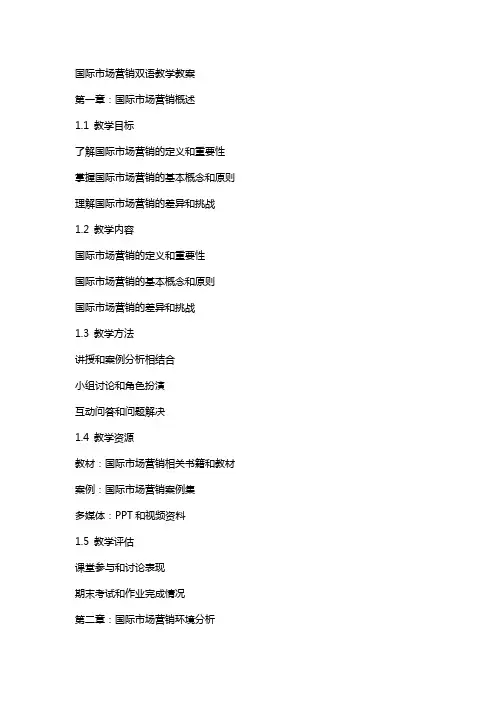
国际市场营销双语教学教案第一章:国际市场营销概述1.1 教学目标了解国际市场营销的定义和重要性掌握国际市场营销的基本概念和原则理解国际市场营销的差异和挑战1.2 教学内容国际市场营销的定义和重要性国际市场营销的基本概念和原则国际市场营销的差异和挑战1.3 教学方法讲授和案例分析相结合小组讨论和角色扮演互动问答和问题解决1.4 教学资源教材:国际市场营销相关书籍和教材案例:国际市场营销案例集多媒体:PPT和视频资料1.5 教学评估课堂参与和讨论表现期末考试和作业完成情况第二章:国际市场营销环境分析2.1 教学目标掌握国际市场营销环境的基本要素理解国际市场营销环境的宏观和微观因素分析国际市场营销环境的变化和趋势2.2 教学内容国际市场营销环境的基本要素国际市场营销的宏观和微观因素国际市场营销环境的变化和趋势2.3 教学方法讲授和案例分析相结合小组讨论和角色扮演互动问答和问题解决2.4 教学资源教材:国际市场营销相关书籍和教材案例:国际市场营销案例集多媒体:PPT和视频资料2.5 教学评估课堂参与和讨论表现期末考试和作业完成情况第三章:国际市场营销策略3.1 教学目标理解国际市场营销策略的基本概念和原则掌握国际市场营销策略的制定和实施过程分析国际市场营销策略的成功案例和失败教训3.2 教学内容国际市场营销策略的基本概念和原则国际市场营销策略的制定和实施过程国际市场营销策略的成功案例和失败教训3.3 教学方法讲授和案例分析相结合小组讨论和角色扮演互动问答和问题解决3.4 教学资源教材:国际市场营销相关书籍和教材案例:国际市场营销案例集多媒体:PPT和视频资料3.5 教学评估课堂参与和讨论表现期末考试和作业完成情况第四章:国际市场营销组合策略4.1 教学目标掌握国际市场营销组合策略的基本要素和原则理解国际市场营销组合策略的制定和实施过程分析国际市场营销组合策略的成功案例和失败教训4.2 教学内容国际市场营销组合策略的基本要素和原则国际市场营销组合策略的制定和实施过程国际市场营销组合策略的成功案例和失败教训4.3 教学方法讲授和案例分析相结合小组讨论和角色扮演互动问答和问题解决4.4 教学资源教材:国际市场营销相关书籍和教材案例:国际市场营销案例集多媒体:PPT和视频资料4.5 教学评估课堂参与和讨论表现期末考试和作业完成情况第五章:国际市场营销渠道和物流5.1 教学目标了解国际市场营销渠道的定义和重要性掌握国际市场营销渠道的类型和运作方式理解国际市场营销渠道的选择和优化策略5.2 教学内容国际市场营销渠道的定义和重要性国际市场营销渠道的类型和运作方式国际市场营销渠道的选择和优化策略5.3 教学方法讲授和案例分析相结合小组讨论和角色扮演互动问答和问题解决5.4 教学资源教材:国际市场营销相关书籍和教材案例:国际市场营销案例集多媒体:PPT和视频资料5.5 教学评估课堂参与和讨论表现期末考试和作业完成情况第六章:国际市场营销沟通策略6.1 教学目标理解国际市场营销沟通的基本概念和原则掌握国际市场营销沟通的策略和工具分析国际市场营销沟通的成功案例和失败教训6.2 教学内容国际市场营销沟通的基本概念和原则国际市场营销沟通的策略和工具国际市场营销沟通的成功案例和失败教训6.3 教学方法讲授和案例分析相结合小组讨论和角色扮演互动问答和问题解决6.4 教学资源教材:国际市场营销相关书籍和教材案例:国际市场营销案例集多媒体:PPT和视频资料6.5 教学评估课堂参与和讨论表现期末考试和作业完成情况第七章:国际市场调研与分析7.1 教学目标掌握国际市场调研的基本概念和原则理解国际市场调研的流程和方法分析国际市场调研的成功案例和失败教训7.2 教学内容国际市场调研的基本概念和原则国际市场调研的流程和方法国际市场调研的成功案例和失败教训7.3 教学方法讲授和案例分析相结合小组讨论和角色扮演互动问答和问题解决7.4 教学资源教材:国际市场营销相关书籍和教材案例:国际市场营销案例集多媒体:PPT和视频资料7.5 教学评估课堂参与和讨论表现期末考试和作业完成情况第八章:国际市场营销文化差异与管理8.1 教学目标理解国际市场营销中文化差异的重要性掌握国际市场营销文化差异的基本概念和原则学习国际市场营销文化差异的管理和适应策略8.2 教学内容国际市场营销中文化差异的重要性国际市场营销文化差异的基本概念和原则国际市场营销文化差异的管理和适应策略8.3 教学方法讲授和案例分析相结合小组讨论和角色扮演互动问答和问题解决8.4 教学资源教材:国际市场营销相关书籍和教材案例:国际市场营销案例集多媒体:PPT和视频资料8.5 教学评估课堂参与和讨论表现期末考试和作业完成情况第九章:国际市场营销风险与伦理9.1 教学目标理解国际市场营销风险的基本概念和类型掌握国际市场营销风险的识别和管理方法学习国际市场营销伦理的重要性及其应用9.2 教学内容国际市场营销风险的基本概念和类型国际市场营销风险的识别和管理方法国际市场营销伦理的重要性及其应用9.3 教学方法讲授和案例分析相结合小组讨论和角色扮演互动问答和问题解决9.4 教学资源教材:国际市场营销相关书籍和教材案例:国际市场营销案例集多媒体:PPT和视频资料9.5 教学评估课堂参与和讨论表现期末考试和作业完成情况第十章:国际市场营销案例分析与实践10.1 教学目标培养学生对国际市场营销案例分析的能力加深学生对国际市场营销理论与实践的理解提升学生的综合分析与决策能力10.2 教学内容选取具有代表性的国际市场营销案例分析案例中的策略、挑战和成功因素结合实际案例进行小组讨论和报告10.3 教学方法案例讨论和分析小组合作和报告教师指导和学生反馈10.4 教学资源案例教材和案例集相关多媒体资料和数据库教师指导材料和反馈表格10.5 教学评估小组报告和讨论表现个人作业和分析报告期末考试和案例分析测试第十一章:国际市场营销战略规划11.1 教学目标理解国际市场营销战略规划的重要性掌握国际市场营销战略规划的基本步骤和工具学习如何制定长期和短期的国际市场营销战略11.2 教学内容国际市场营销战略规划的重要性国际市场营销战略规划的基本步骤和工具长期和短期的国际市场营销战略制定11.3 教学方法讲授和案例分析相结合小组讨论和角色扮演互动问答和问题解决11.4 教学资源教材:国际市场营销相关书籍和教材案例:国际市场营销案例集多媒体:PPT和视频资料11.5 教学评估课堂参与和讨论表现期末考试和作业完成情况第十二章:国际市场营销趋势与未来12.1 教学目标理解国际市场营销的最新趋势掌握国际市场营销的未来发展方向学习如何应对国际市场营销的挑战和机遇12.2 教学内容国际市场营销的最新趋势国际市场营销的未来发展方向如何应对国际市场营销的挑战和机遇12.3 教学方法讲授和案例分析相结合小组讨论和角色扮演互动问答和问题解决12.4 教学资源教材:国际市场营销相关书籍和教材案例:国际市场营销案例集多媒体:PPT和视频资料12.5 教学评估课堂参与和讨论表现期末考试和作业完成情况第十三章:国际市场营销伦理与社会责任13.1 教学目标理解国际市场营销伦理的重要性掌握国际市场营销伦理的基本原则学习国际市场营销中的社会责任和实践13.2 教学内容国际市场营销伦理的重要性国际市场营销伦理的基本原则国际市场营销中的社会责任和实践13.3 教学方法讲授和案例分析相结合小组讨论和角色扮演互动问答和问题解决13.4 教学资源教材:国际市场营销相关书籍和教材案例:国际市场营销案例集多媒体:PPT和视频资料13.5 教学评估课堂参与和讨论表现期末考试和作业完成情况第十四章:国际市场营销模拟与实训14.1 教学目标培养学生实际操作国际市场营销的能力加深学生对国际市场营销理论与实践的理解提升学生的综合分析与决策能力14.2 教学内容模拟国际市场营销环境和场景实际操作国际市场营销策略和计划实训项目和国际市场营销模拟游戏14.3 教学方法实际操作和模拟小组合作和报告教师指导和学生反馈14.4 教学资源实训教材和指导手册相关多媒体资料和数据库教师指导材料和反馈表格14.5 教学评估实训报告和操作表现个人作业和分析报告期末考试和模拟测试第十五章:国际市场营销综合案例研究15.1 教学目标培养学生对国际市场营销案例研究的能力加深学生对国际市场营销理论与实践的理解提升学生的综合分析与决策能力15.2 教学内容选取具有代表性的国际市场营销案例进行深入研究分析案例中的策略、挑战和成功因素结合实际案例进行小组讨论和报告15.3 教学方法案例讨论和分析小组合作和报告教师指导和学生反馈15.4 教学资源案例教材和案例集相关多媒体资料和数据库教师指导材料和反馈表格15.5 教学评估小组报告和讨论表现个人作业和分析报告期末考试和案例分析测试重点和难点解析本文主要介绍了国际市场营销双语教学教案,共分为十五个章节。
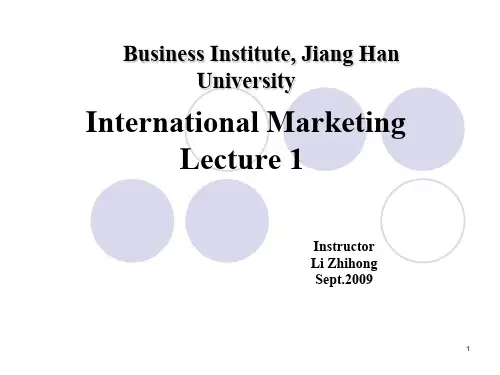
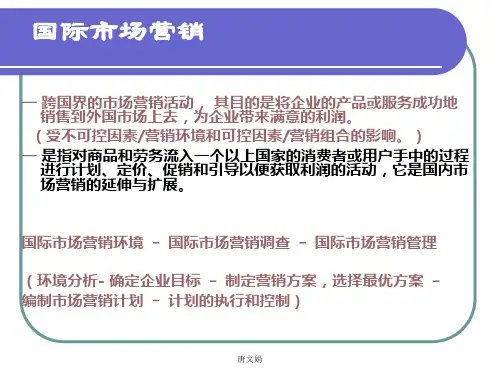
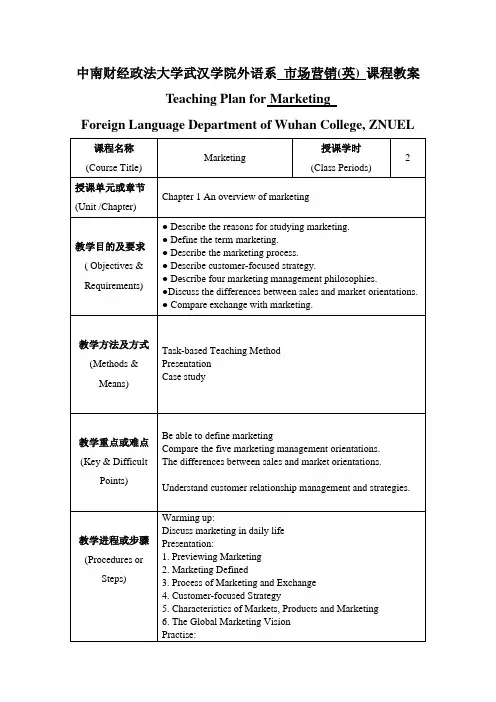
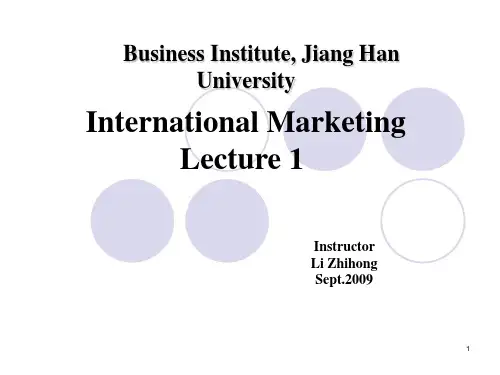
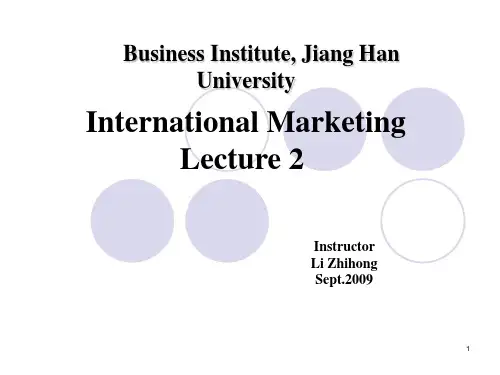
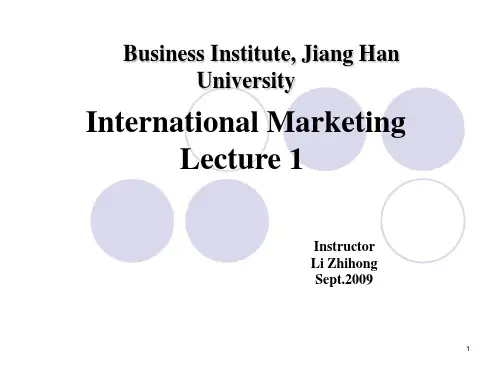
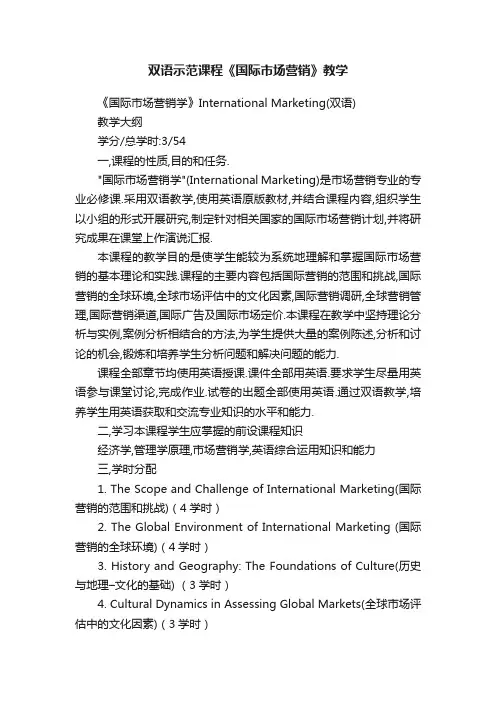
双语示范课程《国际市场营销》教学《国际市场营销学》International Marketing(双语)教学大纲学分/总学时:3/54一,课程的性质,目的和任务."国际市场营销学"(International Marketing)是市场营销专业的专业必修课.采用双语教学,使用英语原版教材,并结合课程内容,组织学生以小组的形式开展研究,制定针对相关国家的国际市场营销计划,并将研究成果在课堂上作演说汇报.本课程的教学目的是使学生能较为系统地理解和掌握国际市场营销的基本理论和实践.课程的主要内容包括国际营销的范围和挑战,国际营销的全球环境,全球市场评估中的文化因素,国际营销调研,全球营销管理,国际营销渠道,国际广告及国际市场定价.本课程在教学中坚持理论分析与实例,案例分析相结合的方法,为学生提供大量的案例陈述,分析和讨论的机会,锻炼和培养学生分析问题和解决问题的能力.课程全部章节均使用英语授课.课件全部用英语.要求学生尽量用英语参与课堂讨论,完成作业.试卷的出题全部使用英语.通过双语教学,培养学生用英语获取和交流专业知识的水平和能力.二,学习本课程学生应掌握的前设课程知识经济学,管理学原理,市场营销学,英语综合运用知识和能力三,学时分配1. The Scope and Challenge of International Marketing(国际营销的范围和挑战)(4学时)2. The Global Environment of International Marketing (国际营销的全球环境)(4学时)3. History and Geography: The Foundations of Culture(历史与地理–文化的基础) (3学时)4. Cultural Dynamics in Assessing Global Markets(全球市场评估中的文化因素)(3学时)5. Culture, Management Style, and Business Systems(文化,管理风格与经营方式) (3学时)6. The Political Environment(政治环境) (3学时)7. The International Legal Environment(国际法律环境) (4学时)8. Developing a Global Vision through Marketing Research(通过营销调研建立全球视野) (4学时)9. Global Marketing Management: Planning and Organization(全球营销管理–计划和组织) (4学时)10. Products and Services for Consumers(面向消费者的产品和服务) (4学时)11. International Marketing Channels(国际营销渠道) (4学时)12. Integrated Marketing Communications and International Advertising(一体化的营销沟通与国际广告) (4学时)13. Personal Selling and Sales Management(人员推销与销售管理) (4学时)14. Pricing for International Markets(国际市场定价) (4学时)15. Review(2学时)四,课程基本要求和内容Part One: An OverviewChapter1:The Scope and Challenge of International Marketing(国际营销的范围和挑战)4学时Learning Objectives(基本要求):T o learn and understand the followings: the scope of the international marketing task; the importance of the cross-cultural analysis in international marketing; the progression of becominga global marketer; the increasing importance of global awareness.1. International Marketing Defined2. The International Marketing Task3. Environmental Adaptation Needed4. The Self-Reference Criterion and Ethnocentrism5. Developing a Global Awareness6. Stages of International Marketing Involvement7. Strategic Orientation8. The Orientation of International MarketingChapter2:The Global Environment of International Marketing (国际营销的全球环境)4学时Learning Objectives(基本要求):To learn and understand the followings: the importance of GA TT and the World Trade Organization; the emergence of the International Monetary Fund and the World Bank Group; the evolution of the European Community to the European Union; the trade linkage of NAFTA and South America and its regional effects; the development of trade within the Asia-Pacific Rim; the growth of developing markets and their importance to regional trade.1. GATT and WTO2. The International Monetary Fund and World Bank Group3. Protests against Global Institutions4. Global Markets and Multinational Market Groups5. Marketing in a Developing CountryPart Two: The Cultural Environment of Global MarketsChapter3: History and Geography: The Foundations of Culture(历史与地理–文化的基础)3学时Learning Objectives(基本要求):To learn and understand the following: the importance of history and geography in the understanding of international markets; the effects of history on a country's culture; effect of geographic diversity on economic profiles of a country; economic effects of controlling population growth versus aging population.1. Historical Perspective in Global Business2. Geography and Global Markets3. Dynamics of Global Population Trends4. World Trade RoutesChapter4: Cultural Dynamics in Assessing Global Markets(全球市场评估中的文化因素)3学时Learning Objectives(基本要求):To learn and understand the following: the importance of culture to an international marketer; the origins and elements of culture; the impact of cultural borrowing;the strategy of planned change and its consequences.1. Culture's Pervasive Impact2. Definitions and Origins of Culture3. Elements of Culture4. Cultural Knowledge5. Cultural ChangeChapter5: Culture, Management Style, and Business Systems(文化,管理风格与经营方式)4学时Learning Objectives(基本要求):To learn and understand the following: the necessity for adapting to cultural differences; how and why management styles vary around the world; the extent and implications of gender bias in some countries; the importance of cultural differences in business ethics; the differences between relationship-oriented and information-oriented cultures.1. Required Adaptation2. Management Styles around the World3. Gender Bias in International Business4. Business Ethics5. Culture's Influence on Strategic Thinking6. A Synthesis, Relationship-Oriented versus Information-Oriented CulturesChapter6: The Political Environment: A Critical Concern (政治环境)4学时Learning Objectives(基本要求):To learn and understand the following: what the sovereignty of nations means and how it affects the stability of government policies, political parties, and nationalism; the political risks of global business and the factors that affect stability; the importance of the political system to international marketing and its effects on foreign investments; assessing and reducing the effects of political vulnerability.1. The Sovereignty of Nations2. Stability of Government Policies3. Political Risks of Global Business4. Assessing Political Vulnerability5. Reducing Political VulnerabilityChapter7: The International Legal Environment(国际法律环境)4学时Learning Objectives(基本要求):To learn and understand the following: the four heritages of today's legal systems; the important factors in jurisdiction of legal disputes; issues associated with jurisdiction of legal disputes and the various methods of dispute resolution; the unique problemsof protecting intellectual property rights internationally; ways to protect against piracy and counterfeiting; the legal differences between countries and how the differences can affect international marketing plans.1. Bases for Legal Systems2. Jurisdiction in International Legal Disputes3. International Dispute Resolution4. Protection of Intellectual Property Rights5. Commercial Law within CountriesPart three: Developing Global Marketing StrategiesChapter 8: Developing a Global Vision through MarketingResearch(通过营销调研建立全球视野)4学时Learning Objectives(基本要求):To learn and understand the following: the importance of problem definition in international research; the problems of availability and use of secondary data; quantitative and qualitative research methods; sources of secondary data; how to analyze and use research information.1. Breadth and Scope of International Marketing Research2. The Research Process3. Defining the Problem and Establishing Research Objectives4. Problems of Availability and Use of Secondary Data5. Gathering Primary Data: Quantitative and Qualitative Research6. Multicultural Research: A Special Problem7. Research on the Internet: A Growing Opportunity8. Estimating Market Demand9. Problems in Analyzing and Interpreting Research Information10. Responsibility for Conducting Marketing Research11. Communicating with Decision MakersChapter9: Global Marketing Management: Planning and Organization(全球营销管理–计划和组织)4学时Learning Objectives(基本要求):To learn and understand the following: how global marketing management differs from international marketing management; the increasing importance of international strategic alliances; the need for planning to achieve company goals; the important factors for each alternative market-entry strategy.1. Global Marketing Management: An Old Debate and a New View2. Planning for Global Markets3. Alternative Market-Entry Strategy4. Organizing for Global CompetitionChapter10: Products and Services for Consumers(面向消费者的产品和服务)4学时Learning Objectives(基本要求):To learn and understand the following: the importance of offering a product suitable for the intended market; the importance of quality and how quality is defined; country-of-origin effects on product image; physical, mandatory, and cultural requirements for product adaptation; the need to view all attributes of a product in order to overcome resistance to acceptance.1. Quality2. Products and Culture3. Analyzing Product Components for Adaptation4. Marketing Consumer Services Globally5. Brands in International MarketsChapter11: International Marketing Channels(国际营销渠道)4学时Learning Objectives(基本要求):To learn and understand the followings: the variety of distribution channels and how they affect cost and efficiency in marketing; how distribution patterns affect the various aspects of international marketing; the growing importance of e-commerce as a distribution alternative; the functions, advantages, and disadvantages of various kinds of middlemen; the importance of middlemen to a product's success and the importance of selecting and maintaining middlemen.1. Channel-of-Distribution Structures2. Distribution Patterns3. Alternative Middleman Choices4. Factors Affecting Choices of Channels5. Locating, Selecting, and Motivating Channel Members6. The InternetChapter12: Integrated Marketing Communications and International Advertising(一体化的营销沟通与国际广告)4学时Learning Objectives(基本要求):To learn and understand the followings: local market characteristics that affect the advertising and promotion of products; the strengths and weaknesses of sales promotion and public relations in global marketing; when global advertising is most effective; when modified advertising is necessary; the effect of limited media, excessive media, and government regulations on advertising and promotion budgets.1. Sales Promotions in International Markets2. International Public Relations3. International Advertising4. Advertising Strategy and Goals5. The Message: Creative Challenge6. Media Planning and Analysis7. Campaign Execution and Advertising Agency8. International Control of AdvertisingChapter13: Personal Selling and Sales Management(人员推销与销售管理)4学时Learning Objectives(基本要求):To learn and understand the followings: the role of interpersonal selling in international marketing; the considerations in designing an international sales force; the steps to recruiting three types of international sales people; selection criteria for international sales and marketing positions; the special training needs of international personnel; motivation techniques for international sales representatives; how to design compensation systems for an international salesforce; the changing profile of the global sales and marketing manager.1. Designing the Sales Force2. Recruiting Marketing and Sales Personnel3. Selecting Sales and Marketing Personnel4. Training for International Marketing5. Motivating Sales Personnel6. Designing Compensation Systems7. Evaluating and Controlling Sales Representatives8. Developing Cultural Awareness9. The Changing Profile of the Global Manager10. Foreign Language SkillsChapter14: Pricing for International Markets(国际市场定价)4学时Learning Objectives(基本要求):To learn and understand the following: components of pricing as competitive tools in international marketing; the pricing pitfalls directly related to international marketing; how to control pricing in parallel imports or gray markets; price escalation and how to minimize its effect; countertrading and its place in international marketing practices; the mechanisms of price quotations.1. Pricing Policy2. Approaches to International Pricing3. Price Escalation4. Approaches to Lessening Price Escalation5. Leasing in International Markets6. Countertrade as a Pricing Tool7. Transfer Pricing Strategy8. Price Quotation9. Administered PricingPart Four :Supplementary Material五,教材及学生参考书教材:Philip Cateora等著International Marketing(国际营销)12th Edition(第12版) 中国人民大学出版社2005年3月参考书:1,Michael R. Czinkota著International Marketing(国际商务) 8th Edition(第8版) 北京大学出版社2007年10月。
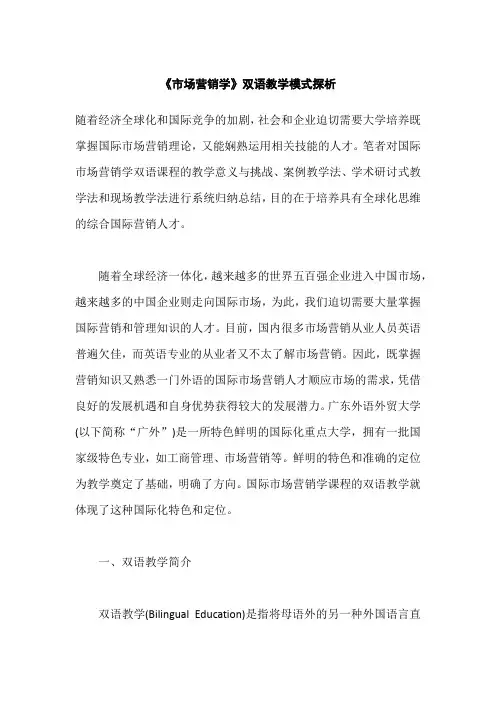
《市场营销学》双语教学模式探析随着经济全球化和国际竞争的加剧,社会和企业迫切需要大学培养既掌握国际市场营销理论,又能娴熟运用相关技能的人才。
笔者对国际市场营销学双语课程的教学意义与挑战、案例教学法、学术研讨式教学法和现场教学法进行系统归纳总结,目的在于培养具有全球化思维的综合国际营销人才。
随着全球经济一体化,越来越多的世界五百强企业进入中国市场,越来越多的中国企业则走向国际市场,为此,我们迫切需要大量掌握国际营销和管理知识的人才。
目前,国内很多市场营销从业人员英语普遍欠佳,而英语专业的从业者又不太了解市场营销。
因此,既掌握营销知识又熟悉一门外语的国际市场营销人才顺应市场的需求,凭借良好的发展机遇和自身优势获得较大的发展潜力。
广东外语外贸大学(以下简称“广外”)是一所特色鲜明的国际化重点大学,拥有一批国家级特色专业,如工商管理、市场营销等。
鲜明的特色和准确的定位为教学奠定了基础,明确了方向。
国际市场营销学课程的双语教学就体现了这种国际化特色和定位。
一、双语教学简介双语教学(Bilingual Education)是指将母语外的另一种外国语言直接应用于非语言类课程教学,并使外语与学科知识同步获取的一种教学模式,使学生在获取学科知识的同时培养和提高运用外语的能力。
欧盟采用的英文表述Content and Language Integrated Learning(学科内容与语言整合),则较好地反映了双语教学的本质特征,特别是外语作为学校非语言学科教学媒介的双语教学。
换句话说,双语教学的本质是学科内容与语言技能的整合,这种整合中既有学科专业知识的教学,又有除母语以外的一门外语(主要是英语)作为课堂主要用语进行教学。
如果要将双语教学中专业知识与外语的重要性做个比较,对于非语言类的学科来讲,笔者以为专业知识的掌握更重要,而外语只是一门将专业知识与国际接轨的工具。
当然,这个工具也很重要,没有它我们将很难吸收到世界上最先进的科学知识。
课程教案(2013—2014学年第二学期)课程名称:市场营销学(双语)授课学时: 34学时授课班级:任课教师:开课院系:经管学院课程信息070214: 市场营销学(双语)Class ScheduleCHAPTER 1Marketing: Managing Profitable Customer Relationships一、教学目的引导学生理解营销的含义,营销过程的五个步骤—理解市场和消费者需要,设计客户驱动型的营销战略,构建营销方案,建立客户关系,以及从客户处获取价值。
二、教学重点及难点重点:营销领域的五个核心概念:需要、欲望、需求;产品;价值、满意;交换、交易和关系;市场。
设计客户驱动型的营销战略:五种不同的营销理念。
难点:从客户处获取价值:创造客户忠诚和客户资产三、教学手段及方法多媒体课件讲授,课堂小组讨论,重要知识点提问,观看相关的影音资料,章节小结及作业布置。
*注重启发并理论联系实际。
四、教学内容与教学设计LEARNING OBJECTIVES:⏹Define marketing and the steps in the marketing process.⏹Explain the core marketing concepts.⏹Define marketing management and examine how marketers manage demandand build profitable customer relationships.⏹Compare the five marketing management philosophies.⏹Capturing value from customer.1 What Is Marketing?●Marketing is managing profitable customer relationships.●Must both attract new customers and grow the current customers.Discussion QuestionLet students discuss what is marketing and provide examples about marketing through their experience.2 The Marketing Process●Understand the marketplace and customer needs and wants●Design a customer-driven marketing strategy●Construct a marketing program that delivers superior value●Build profitable relationships and create customer delight●Capture value from customers to create profits and customer equity3 Understanding the Marketplace and Consumer NeedsNeeds, wants and demands; Marketing offers (products, services, and experiences);Value and satisfaction; Exchanges, transactions, and relationships; Markets.Needs, Wants, and DemandsHuman need include physical needs (food, clothing, safety); social needs (belonging, affection); and individual needs (knowledge, self-expression).Wants become demands when they are backed by buying power.Marketing Offers—Products, Services, and ExperiencesA marketing offer is a combination of products, services, information or experiences offered to satisfy a need or want.Marketing myopia is paying more attention to the individual products offered, rather than the need satisfied, or benefits produced.Value and SatisfactionDiscussion Question⏹Form small groups, and select a brand of athletic shoes that a group memberhas purchased recently.⏹What Customer Value did the group member expect?⏹Did the member experience Customer Satisfaction? Why or why not? MarketsA market is defined as the set of actual and potential buyers of a product.Marketers must manage markets to create the desired exchange relationships.4 Marketing Management philosophiesThe production concept says that consumers will favor products that are available and affordable.The product concept,consumers favor products that are highest in quality, performance, and innovation.The selling concept undertake large-scale selling and promotional effort to get consumers to buy.The marketing concept says that the company needs to understand the needs and wants of the target markets and deliver satisfaction better than their competitors do. The societal marketing concept is a relatively new concept that asks companies to not overlook consumer long-run welfare while meeting their short-run wants.Discussion Question⏹What is the single biggest difference between the marketing concept and theproduction, product, and selling concepts?⏹Which concepts are easier to adopt in the short-run? Which concept offers thebest chances of long-run success? Why?5Building Customer RelationshipsCustomer Relationship ManagementCustomer Relationship Management (CRM)is the overall process of building and maintaining profitable customer relationships by delivering superior customer value and satisfaction.6 Capturing Value from CustomersCreating Customer Loyalty and RetentionCustomer lifetime value is an important concept that says that if you lose a customer, you don’t just lose one sale. You potentially lose thousands or even hundreds of thousands that a customer could spend over their lifetime.Discussion Question⏹Think of a service provider to who you are loyal.⏹What do you do (your behaviors, actions, feelings) that indicates you areloyal?⏹Why are you loyal to this provider?⏹What factors have influenced the formation of your loyalty?Growing Share of CustomerT he share the company gets of that customer’s total spending on the product or service type.Companies can grow share of customer by offering greater variety to their current customers.Building Customer EquityCustomer equity is the total combined li fetime values of all the company’s customers.Customer equity forecasts the future, whereas sales and market share tell what happened in the past.Companies can classify their customers as to whether they are profitable or not, and then manage the relationships accordingly.A key learning is that different types of customers require different management strategies to maintain and increase profitability.。